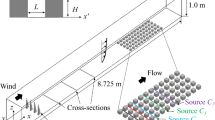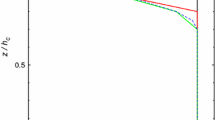Abstract
Two-point, space-time correlations of streamwise and vertical velocity were obtained from a wind tunnel simulation of an atmospheric surface layer with an underlying model wheat canopy constructed of flexible nylon stalks. Velocity data extend from 1/6 canopy height to several canopy heights, with in excess of 2000 three-dimensional vector separations of the two x-wire probes. Isocorrelation contours over anx, z slice show the streamwise velocity autocorrelation to be roughly circular, such that vertical velocities at the same horizontal position but different heights are closely in phase. Cross-correlations between the two velocity components reflect this difference to some extent. Lateral displacements of the probes revealed side lobes with correlations of reversed sign but we cannot positively link this pattern to particular vorticular structures. Integral length scales obtained directly from the spatial correlations match similar scales deduced from single-point time series with Taylor's hypothesis at 2 to 3 times the canopy height but greatly exceed such scales at lower levels, particularly within the wheat. We conclude that the reversed sign lateral lobes are important components of the correlation field and that an integral length scale for the lateral direction must be defined such that they are included. Convective velocities obtained from the time lag to optimally restore correlation lost by physical separation of the probes change only slowly with height and greatly exceed the mean wind velocity within and immediately above the canopy. Thus, mean wind velocity is not a suitable proxy for convective velocity in the application of Taylor's hypothesis in this situation. The ratio of vertical to longitudinal convective velocity for the streawise velocity signal yields a downwind tilt angle of about 39° which is probably a better estimate of the slope of the dominant fluid motions than the tilt of the major axis of the isocorrellation contours mentioned previously.
Similar content being viewed by others
References
Antonia, R. A., Browne, L. W. B., and Bisset, D. K.: 1988, ‘Effects of Reynolds Number on the Organized Motion in a Turbulent Boundary Layer’,Proc. Zaric Memorial International Seminar on Wall Turbulence, Dubrovnik, pp. 16–20.
Aylor, D. E., Wang, Y., and Miller, D. R.: 1993, ‘Intermittent Wind Close to the Ground Within a Grass Canopy’,Boundary-Layer Meteorol. 66, 427–448.
Baldocchi, D. D. and Meyers, T. P.: 1988, ‘A Spectral and Lag-Correlation Analysis of Turbulence in a Deciduous Forest Canopy’,Boundary-Layer Meteorol. 45, 31–58.
Berkooz, G., Holmes, P., and Lumley, J. L.: 1993, ‘The Proper Orthogonal Decomposition in the Analysis of Turbulent Flows’,Annu. Rev. Fluid Mech. 25, 539–575.
Brunet, Y., Finnigan, J. J., and Raupach, M. R.: 1994, ‘A Wind Tunnel Study of Air Flow in Waving Wheat: Single-Point Velocity Statistics’,Boundary-Layer Meteorol. 70, 95–132.
Finningan, J. J. and Mulhearn, P. J.: 1978, ‘Modelling Waving Crops in a Wind Tunnel”,Boundary-Layer Meteorol. 14, 253–277.
Gao, W., Shaw, R. H., and Paw U, K. T.: 1989 ‘Observations of Organized Structure in Turbulent Flow Within and Above a Forest Canopy’,Boundary-Layer Meteorol. 47, 349–377.
Kaimal, J. C.: 1974, ‘Translation Speed of Convective Plumes in the Atmospheric Surface Layer”,Quart. J. Roy. Met. Soc. 100, 46–52.
Kaimal, J. C., Wyngaard, J. C., Izumi, Y., and Coté, O. R.: 1972, ‘Spectral Characteristics of Surface-Layer Turbulence’,Quart. J. Roy. Met. Soc. 98, 563–589.
Legg, B. J., Coppin, P. C., and Raupach, M. R.: 1984, ‘A Three-Hot-Wire Anemometer for Measuring Two Velocity Components in High Intensity Turbulent Boundary-Layers’,J. Phys. E. 17, 970–976.
Moin, P. and Moser, R. D.: 1989, ‘Characteristic-Eddy Decomposition of Turbulence in a Channel’,J. Fluid Mech. 200, 471–509.
Morris, Jr., A. H.: 1993, ‘NSWC Library of Mathematical Subroutines’, Naval Surface Warfare Center, Dahlgren, Virginia, 523–525.
Perry, A. E. and Li, J. D.: 1990, ‘Experimental Support for the Attached-Eddy Hypothesis in Zero-Pressure-Gradient Turbulent Boundary Layers’,J. Fluid Mech. 218, 405–438.
Raupach, M. R., Coppin, P. A., and Legg, B. J.: 1986, ‘Experiments on Scalar Dispersion within a Plant Canopy, Part I: the Turbulence Structure’,Boundary-Layer Meteorol. 35, 21–52.
Raupach, M. R., Finnigan, J. J., and Brunet, Y.: 1989, ‘Coherent Eddies in Vegetation Canopies”,Proc. Fourth Australasian Conference on Heat and Mass Transfer, Christchurch, New Zealand, 9–12 May 1989, 75–90.
Raupach, M. R., Antonia, R. A., and Rajagopalan, S.: 1991, ‘Rough-Wall Turbulent Boundary Layers’,Appl. Mechanics Revs. 44, 1–25.
Shaw, R. H., den Hartog, G., and Neumann, H. H.: 1988, ‘Influence of Foliar Density and Thermal Stability on Profiles of Reynolds Stress and Turbulence Intensity in a Deciduous Forest’,Boundary-Layer Meteorol. 45, 391–409.
Townsend, A. A.: 1976,The Structure of Turbulent Shear Flow, Cambridge University Press, Cambridge, 429 pp.
Wilson, J. D., Ward, D. P., Thurtell, G. W., and Kidd, G. E.: 1982, ‘Statistics of Atmospheric Turbulence Within and Above a Corn Canopy’,Boundary-Layer Meteorol. 24, 495–519.
Wilczak, J. M. and Tillman, J. E.: 1980, ‘The Three-Dimensional Structure of Convection in the Atmospheric Surface Layer’,J. Atmos. Sci. 37, 2424–2443.
Wooding, R. A.: 1968, ‘A Low Speed Wind Tunnel for Model Studies in Micrometeorology. II. The Pye Laboratory Wind Tunnel’,Aust. CSIRO Div. Plant Ind. Tech. Pap., No 25, pp. 1–24.
Wygnanski, I. and Fiedler, H. E.: 1970, ‘The Two-Dimensional Mixing Region’,J. Fluid Mech. 41, 327–361.
Zaman, K. B. M. Q. and Hussain, A. K. M. F.: 1981, ‘Taylor Hypothesis and Large-Scale Coherent Structures’,J. Fluid Mech. 112, 379–396.
Zhang, C., Shaw, R. H., and Paw U, K. T.: 1992, ‘Spatial Characteristics of Turbulent Coherent Structures Within and Above an Orchard Canopy’, in S. E. Schwartz and W. G. N. Slim (coordinators),Precipitation Scavenging and Atmosphere-Surface Exchange, Vol. 2. Hemisphere Publishing Co., Washington, pp. 741–751.
Author information
Authors and Affiliations
Rights and permissions
About this article
Cite this article
Shaw, R.H., Brunet, Y., Finnigan, J.J. et al. A wind tunnel study of air flow in waving wheat: Two-point velocity statistics. Boundary-Layer Meteorol 76, 349–376 (1995). https://doi.org/10.1007/BF00709238
Revised:
Issue Date:
DOI: https://doi.org/10.1007/BF00709238




